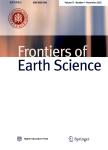Trace elements of pyrite and S,H,O isotopes from the Laowan gold deposit in Tongbai,Henan Province,China:implications for ore genesis
作者机构:Faculty of Earth ResourcesChina University of GeosciencesWuhan430074China State Key Laboratory of Geological Processes and Mineral ResourcesChina University of GeosciencesWuhan430074China No.1 Geological Exploration InstituteHenan Bureau of Geo-exploration and Mineral DevelopmentZhengzhou450001China
出 版 物:《Frontiers of Earth Science》 (地球科学前沿(英文版))
年 卷 期:2020年第14卷第3期
页 面:578-600页
核心收录:
学科分类:081803[工学-地质工程] 08[工学] 0818[工学-地质资源与地质工程] 0708[理学-地球物理学] 0704[理学-天文学]
基 金:This research was supported by the Project of the Nanyang Basin and Orogenic Belt Metallogenic Diversity Research(No.2014-49)supported by No.1 Geological Exploration Institute Henan Bureau of Geo-exploration and Mineral Development.
主 题:pyrite trace elements S-H-0 isotopes genesis Laowan gold deposit
摘 要:The Laowan deposit is a large gold deposit in the Qinling-Dabie orogenic belt where pyrite is the main Au-bearing mineral phase.We present results from the occurrences of gold,trace elements and sulfur isotopes of pyrite,and hydrogen and oxygen isotopes of quartz and calcite to elucidate the sources of ore-forming fluid;the genesis of pyrite and the ore-forming process.From field observations,five generations of pyrite are identified;one formed in a metamorphic-diagenetic epoch(PyI),and the others during four mineralization stages:1)the coarse-grained pyrite-quartz stage(PyII),2)the quartz and medium-to fine-grained pyrite stage(PyIII),3)the polymetallic sulfide stage(PyIV),and 4)the carbonate-quartz stage(PyV).Gold mainly occurs in PyIII and PyIV.We find that Au,Ag,Pb,and Cu are incorporated into pyrite as micro-/nano-inclusions and that Co,Ni,As,and Se enter the pyrite lattice via isomorphous replacement.The Co/Ni values and Se concentrations indicate that PyI formed from metamorphic hydrothermal fluids and that pyrites(PyII,PyIII,and PyIV)from the ore-forming stages typically reflect a hydrothermal genesis involving magmatic fluid.Theδ^34S values of PyI(1.45‰-2.09‰)are similar to that of plagioclase amphibole schist,indicating that S was primarily derived from wall rock,while those of PyII,PyIII,and PyIV(3.10‰-5.55‰)suggest that S was derived from the Guishanyan Formation and the Laowan granite.The four mineralization stages show a systematic decrease inδD(from−77.1‰to−82.8‰,−84.7‰,and−102.7‰),while theδ^18OH2O values showed a gradual decrease from 5.7 to 2.7‰,1.0‰,and−1.3‰.These data show that the ore-forming fluid was similar to a mixture of magmatic and meteoric waters.Thus,we conclude that the Laowan gold deposit is related to magmatic-hydrothermal fluid.



